Project Management Analysis: Melamchi Water Supply Project, Nepal
VerifiedAdded on 2022/11/17
|24
|4787
|114
Report
AI Summary
This report provides a comprehensive analysis of the Melamchi Water Supply Project in Nepal, focusing on the lessons learned from its implementation. It identifies key challenges, including poor environmental factors, weak project governance, contractual and human resource management issues, communication breakdowns, and legislative hurdles. The report details how these factors contributed to project delays and budget overruns. It further explores the importance of stakeholder management, risk mitigation, and effective contract and communication strategies. The report proposes solutions such as stakeholder management plans, risk registers, and communication plans. The report also provides detailed insights into the project's context, including its objectives, environmental considerations, and decision-making processes. The report concludes with recommendations to improve project outcomes and avoid similar issues in future projects. Appendices include a risk register, stakeholder management plan, and communication plan.
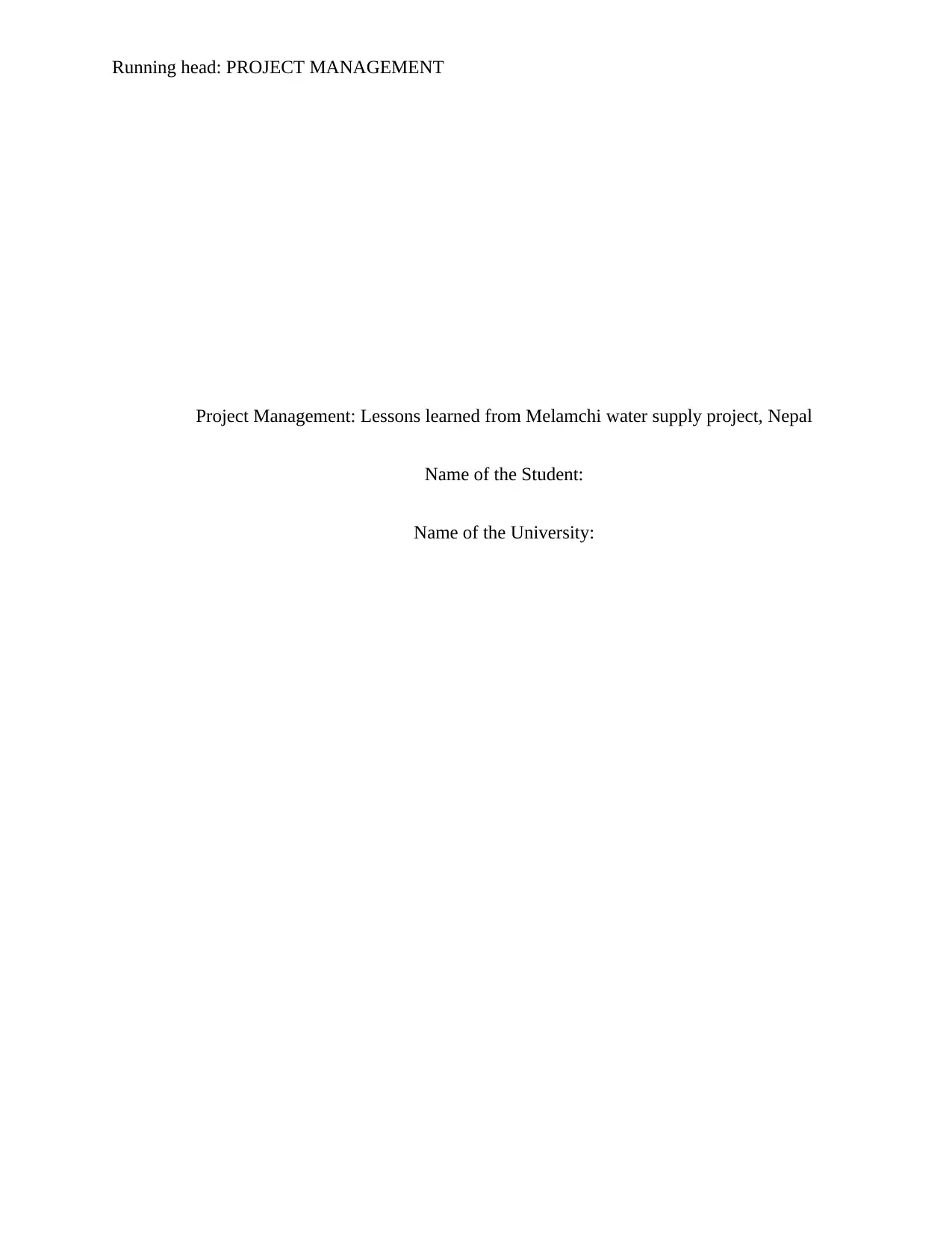
Running head: PROJECT MANAGEMENT
Project Management: Lessons learned from Melamchi water supply project, Nepal
Name of the Student:
Name of the University:
Project Management: Lessons learned from Melamchi water supply project, Nepal
Name of the Student:
Name of the University:
Paraphrase This Document
Need a fresh take? Get an instant paraphrase of this document with our AI Paraphraser
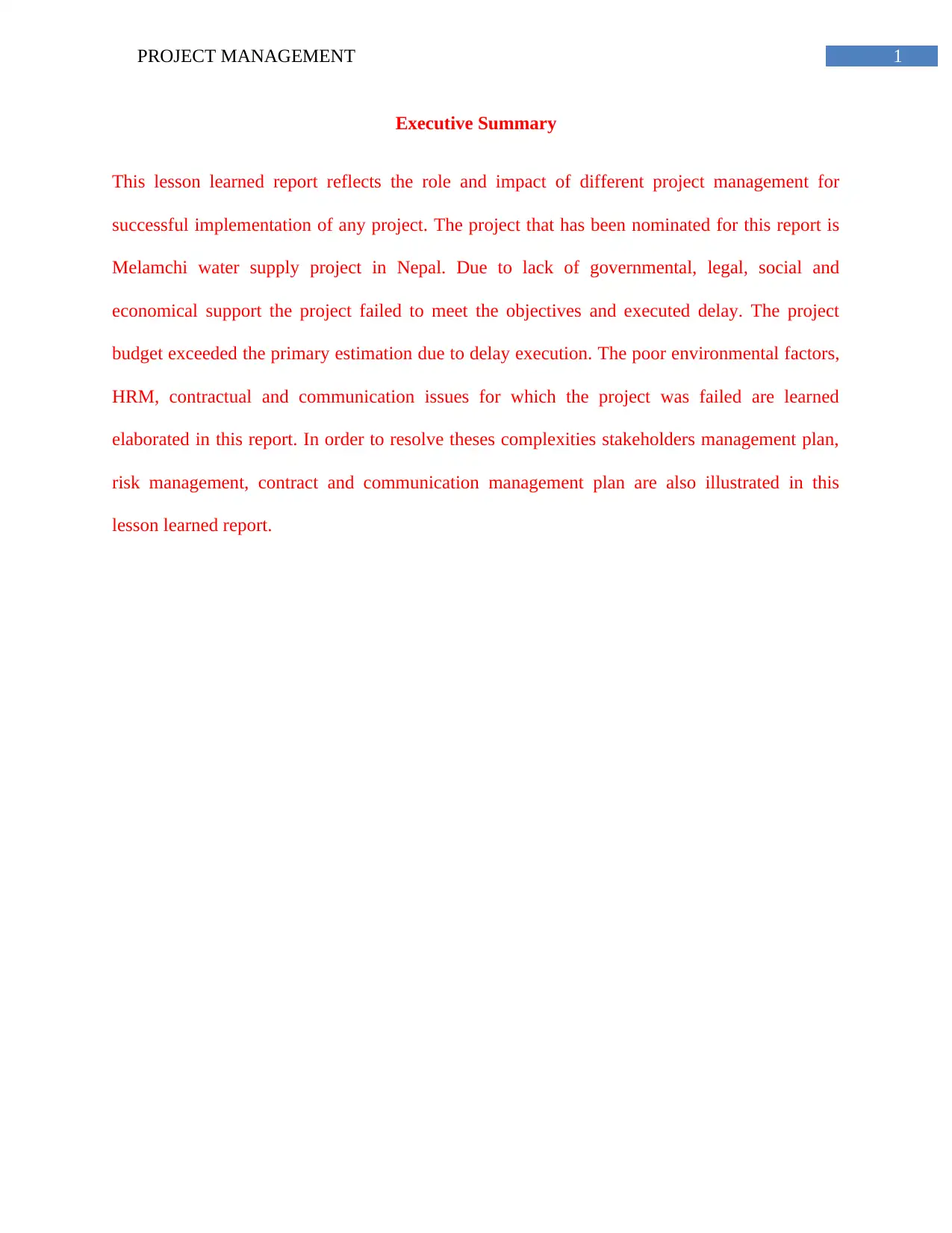
1PROJECT MANAGEMENT
Executive Summary
This lesson learned report reflects the role and impact of different project management for
successful implementation of any project. The project that has been nominated for this report is
Melamchi water supply project in Nepal. Due to lack of governmental, legal, social and
economical support the project failed to meet the objectives and executed delay. The project
budget exceeded the primary estimation due to delay execution. The poor environmental factors,
HRM, contractual and communication issues for which the project was failed are learned
elaborated in this report. In order to resolve theses complexities stakeholders management plan,
risk management, contract and communication management plan are also illustrated in this
lesson learned report.
Executive Summary
This lesson learned report reflects the role and impact of different project management for
successful implementation of any project. The project that has been nominated for this report is
Melamchi water supply project in Nepal. Due to lack of governmental, legal, social and
economical support the project failed to meet the objectives and executed delay. The project
budget exceeded the primary estimation due to delay execution. The poor environmental factors,
HRM, contractual and communication issues for which the project was failed are learned
elaborated in this report. In order to resolve theses complexities stakeholders management plan,
risk management, contract and communication management plan are also illustrated in this
lesson learned report.
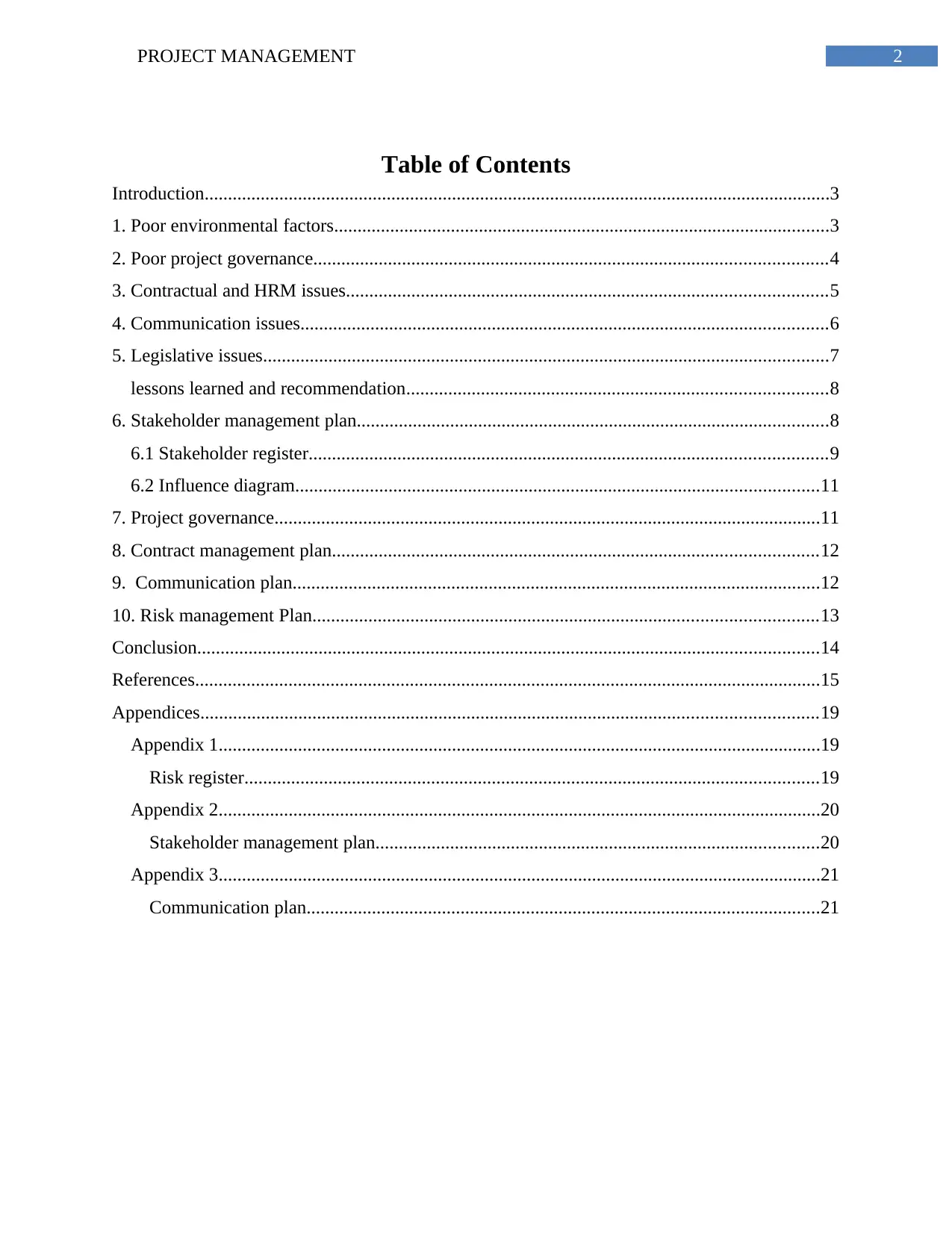
2PROJECT MANAGEMENT
Table of Contents
Introduction......................................................................................................................................3
1. Poor environmental factors..........................................................................................................3
2. Poor project governance..............................................................................................................4
3. Contractual and HRM issues.......................................................................................................5
4. Communication issues.................................................................................................................6
5. Legislative issues.........................................................................................................................7
lessons learned and recommendation..........................................................................................8
6. Stakeholder management plan.....................................................................................................8
6.1 Stakeholder register...............................................................................................................9
6.2 Influence diagram................................................................................................................11
7. Project governance.....................................................................................................................11
8. Contract management plan........................................................................................................12
9. Communication plan.................................................................................................................12
10. Risk management Plan............................................................................................................13
Conclusion.....................................................................................................................................14
References......................................................................................................................................15
Appendices....................................................................................................................................19
Appendix 1.................................................................................................................................19
Risk register...........................................................................................................................19
Appendix 2.................................................................................................................................20
Stakeholder management plan...............................................................................................20
Appendix 3.................................................................................................................................21
Communication plan..............................................................................................................21
Table of Contents
Introduction......................................................................................................................................3
1. Poor environmental factors..........................................................................................................3
2. Poor project governance..............................................................................................................4
3. Contractual and HRM issues.......................................................................................................5
4. Communication issues.................................................................................................................6
5. Legislative issues.........................................................................................................................7
lessons learned and recommendation..........................................................................................8
6. Stakeholder management plan.....................................................................................................8
6.1 Stakeholder register...............................................................................................................9
6.2 Influence diagram................................................................................................................11
7. Project governance.....................................................................................................................11
8. Contract management plan........................................................................................................12
9. Communication plan.................................................................................................................12
10. Risk management Plan............................................................................................................13
Conclusion.....................................................................................................................................14
References......................................................................................................................................15
Appendices....................................................................................................................................19
Appendix 1.................................................................................................................................19
Risk register...........................................................................................................................19
Appendix 2.................................................................................................................................20
Stakeholder management plan...............................................................................................20
Appendix 3.................................................................................................................................21
Communication plan..............................................................................................................21
⊘ This is a preview!⊘
Do you want full access?
Subscribe today to unlock all pages.

Trusted by 1+ million students worldwide
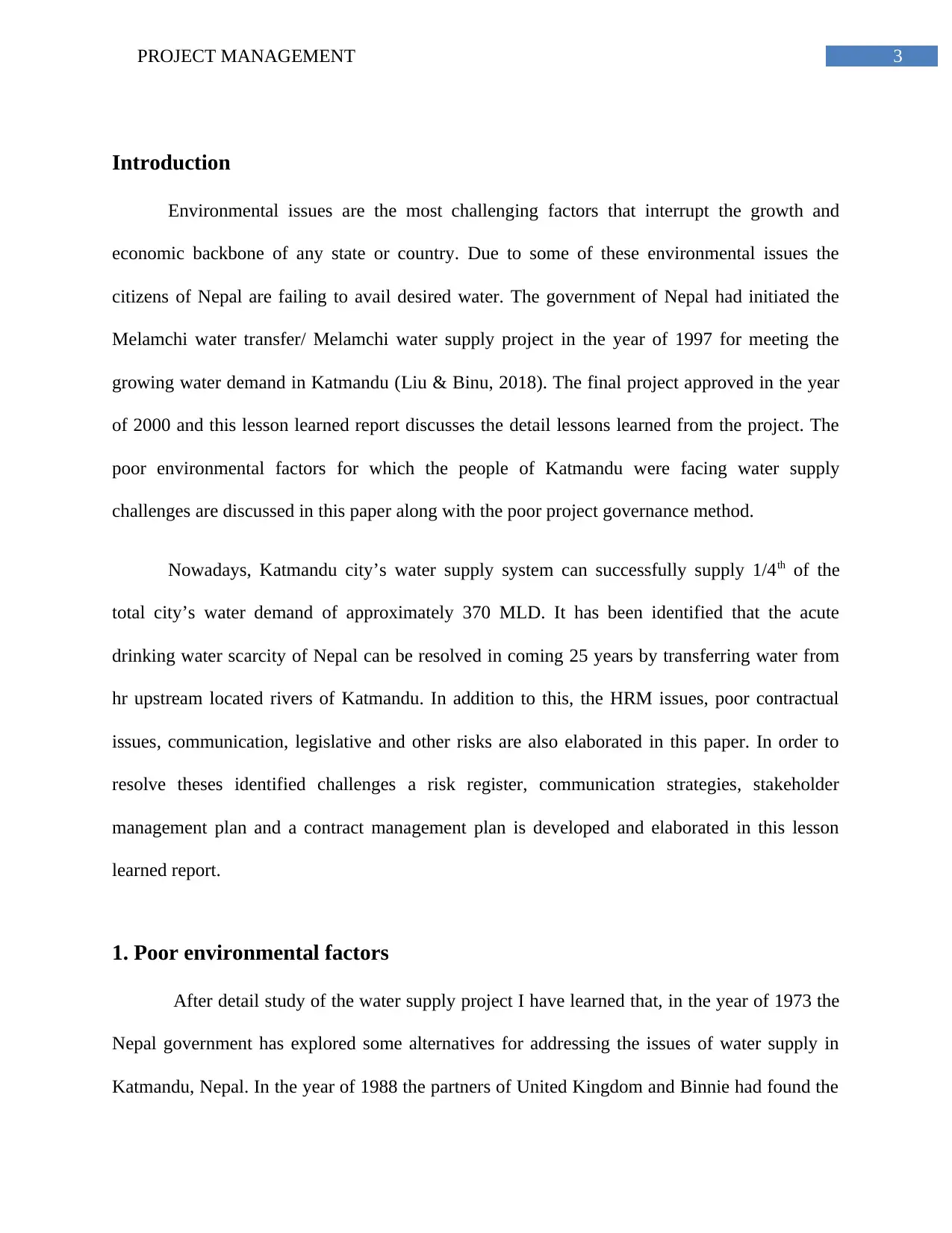
3PROJECT MANAGEMENT
Introduction
Environmental issues are the most challenging factors that interrupt the growth and
economic backbone of any state or country. Due to some of these environmental issues the
citizens of Nepal are failing to avail desired water. The government of Nepal had initiated the
Melamchi water transfer/ Melamchi water supply project in the year of 1997 for meeting the
growing water demand in Katmandu (Liu & Binu, 2018). The final project approved in the year
of 2000 and this lesson learned report discusses the detail lessons learned from the project. The
poor environmental factors for which the people of Katmandu were facing water supply
challenges are discussed in this paper along with the poor project governance method.
Nowadays, Katmandu city’s water supply system can successfully supply 1/4th of the
total city’s water demand of approximately 370 MLD. It has been identified that the acute
drinking water scarcity of Nepal can be resolved in coming 25 years by transferring water from
hr upstream located rivers of Katmandu. In addition to this, the HRM issues, poor contractual
issues, communication, legislative and other risks are also elaborated in this paper. In order to
resolve theses identified challenges a risk register, communication strategies, stakeholder
management plan and a contract management plan is developed and elaborated in this lesson
learned report.
1. Poor environmental factors
After detail study of the water supply project I have learned that, in the year of 1973 the
Nepal government has explored some alternatives for addressing the issues of water supply in
Katmandu, Nepal. In the year of 1988 the partners of United Kingdom and Binnie had found the
Introduction
Environmental issues are the most challenging factors that interrupt the growth and
economic backbone of any state or country. Due to some of these environmental issues the
citizens of Nepal are failing to avail desired water. The government of Nepal had initiated the
Melamchi water transfer/ Melamchi water supply project in the year of 1997 for meeting the
growing water demand in Katmandu (Liu & Binu, 2018). The final project approved in the year
of 2000 and this lesson learned report discusses the detail lessons learned from the project. The
poor environmental factors for which the people of Katmandu were facing water supply
challenges are discussed in this paper along with the poor project governance method.
Nowadays, Katmandu city’s water supply system can successfully supply 1/4th of the
total city’s water demand of approximately 370 MLD. It has been identified that the acute
drinking water scarcity of Nepal can be resolved in coming 25 years by transferring water from
hr upstream located rivers of Katmandu. In addition to this, the HRM issues, poor contractual
issues, communication, legislative and other risks are also elaborated in this paper. In order to
resolve theses identified challenges a risk register, communication strategies, stakeholder
management plan and a contract management plan is developed and elaborated in this lesson
learned report.
1. Poor environmental factors
After detail study of the water supply project I have learned that, in the year of 1973 the
Nepal government has explored some alternatives for addressing the issues of water supply in
Katmandu, Nepal. In the year of 1988 the partners of United Kingdom and Binnie had found the
Paraphrase This Document
Need a fresh take? Get an instant paraphrase of this document with our AI Paraphraser
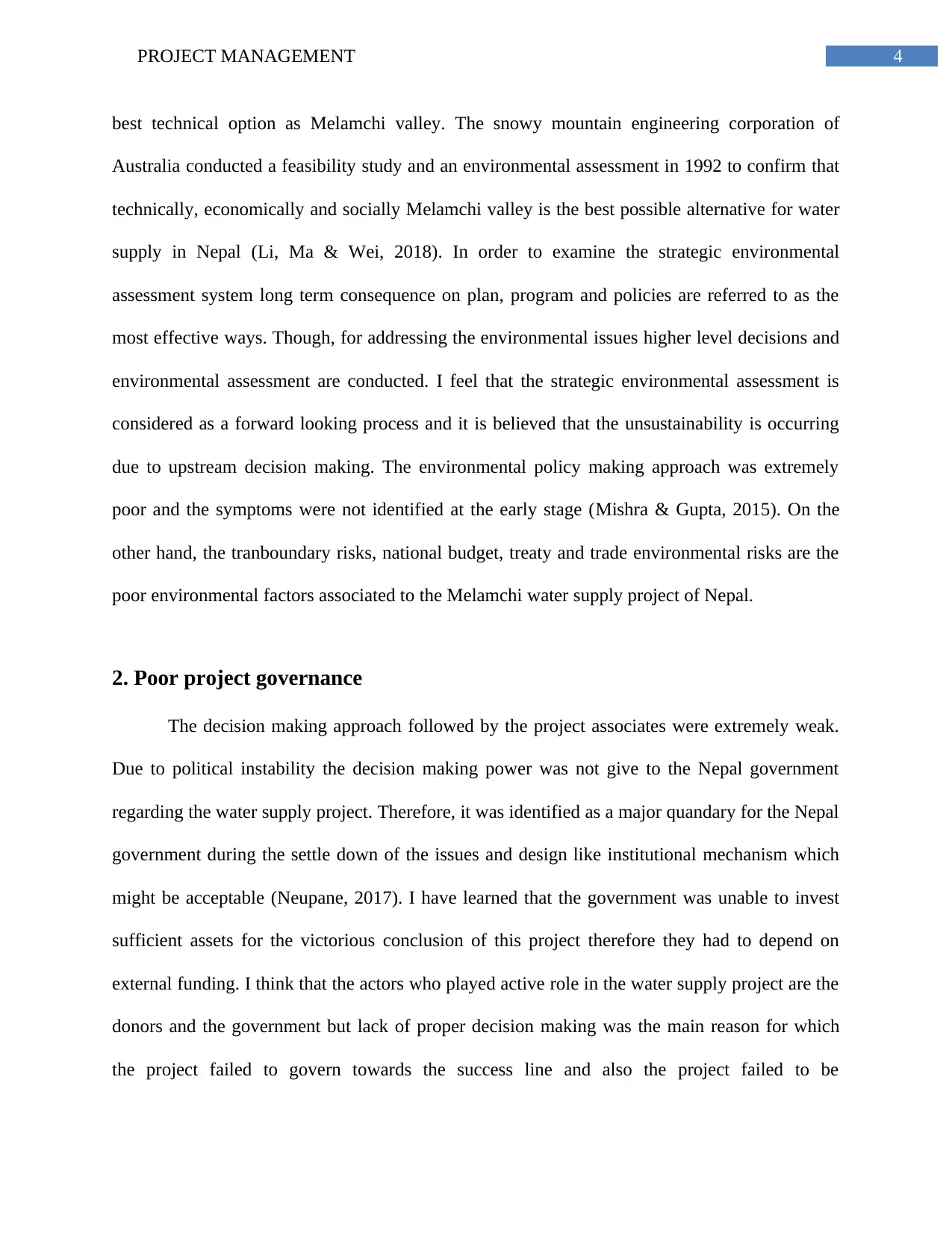
4PROJECT MANAGEMENT
best technical option as Melamchi valley. The snowy mountain engineering corporation of
Australia conducted a feasibility study and an environmental assessment in 1992 to confirm that
technically, economically and socially Melamchi valley is the best possible alternative for water
supply in Nepal (Li, Ma & Wei, 2018). In order to examine the strategic environmental
assessment system long term consequence on plan, program and policies are referred to as the
most effective ways. Though, for addressing the environmental issues higher level decisions and
environmental assessment are conducted. I feel that the strategic environmental assessment is
considered as a forward looking process and it is believed that the unsustainability is occurring
due to upstream decision making. The environmental policy making approach was extremely
poor and the symptoms were not identified at the early stage (Mishra & Gupta, 2015). On the
other hand, the tranboundary risks, national budget, treaty and trade environmental risks are the
poor environmental factors associated to the Melamchi water supply project of Nepal.
2. Poor project governance
The decision making approach followed by the project associates were extremely weak.
Due to political instability the decision making power was not give to the Nepal government
regarding the water supply project. Therefore, it was identified as a major quandary for the Nepal
government during the settle down of the issues and design like institutional mechanism which
might be acceptable (Neupane, 2017). I have learned that the government was unable to invest
sufficient assets for the victorious conclusion of this project therefore they had to depend on
external funding. I think that the actors who played active role in the water supply project are the
donors and the government but lack of proper decision making was the main reason for which
the project failed to govern towards the success line and also the project failed to be
best technical option as Melamchi valley. The snowy mountain engineering corporation of
Australia conducted a feasibility study and an environmental assessment in 1992 to confirm that
technically, economically and socially Melamchi valley is the best possible alternative for water
supply in Nepal (Li, Ma & Wei, 2018). In order to examine the strategic environmental
assessment system long term consequence on plan, program and policies are referred to as the
most effective ways. Though, for addressing the environmental issues higher level decisions and
environmental assessment are conducted. I feel that the strategic environmental assessment is
considered as a forward looking process and it is believed that the unsustainability is occurring
due to upstream decision making. The environmental policy making approach was extremely
poor and the symptoms were not identified at the early stage (Mishra & Gupta, 2015). On the
other hand, the tranboundary risks, national budget, treaty and trade environmental risks are the
poor environmental factors associated to the Melamchi water supply project of Nepal.
2. Poor project governance
The decision making approach followed by the project associates were extremely weak.
Due to political instability the decision making power was not give to the Nepal government
regarding the water supply project. Therefore, it was identified as a major quandary for the Nepal
government during the settle down of the issues and design like institutional mechanism which
might be acceptable (Neupane, 2017). I have learned that the government was unable to invest
sufficient assets for the victorious conclusion of this project therefore they had to depend on
external funding. I think that the actors who played active role in the water supply project are the
donors and the government but lack of proper decision making was the main reason for which
the project failed to govern towards the success line and also the project failed to be
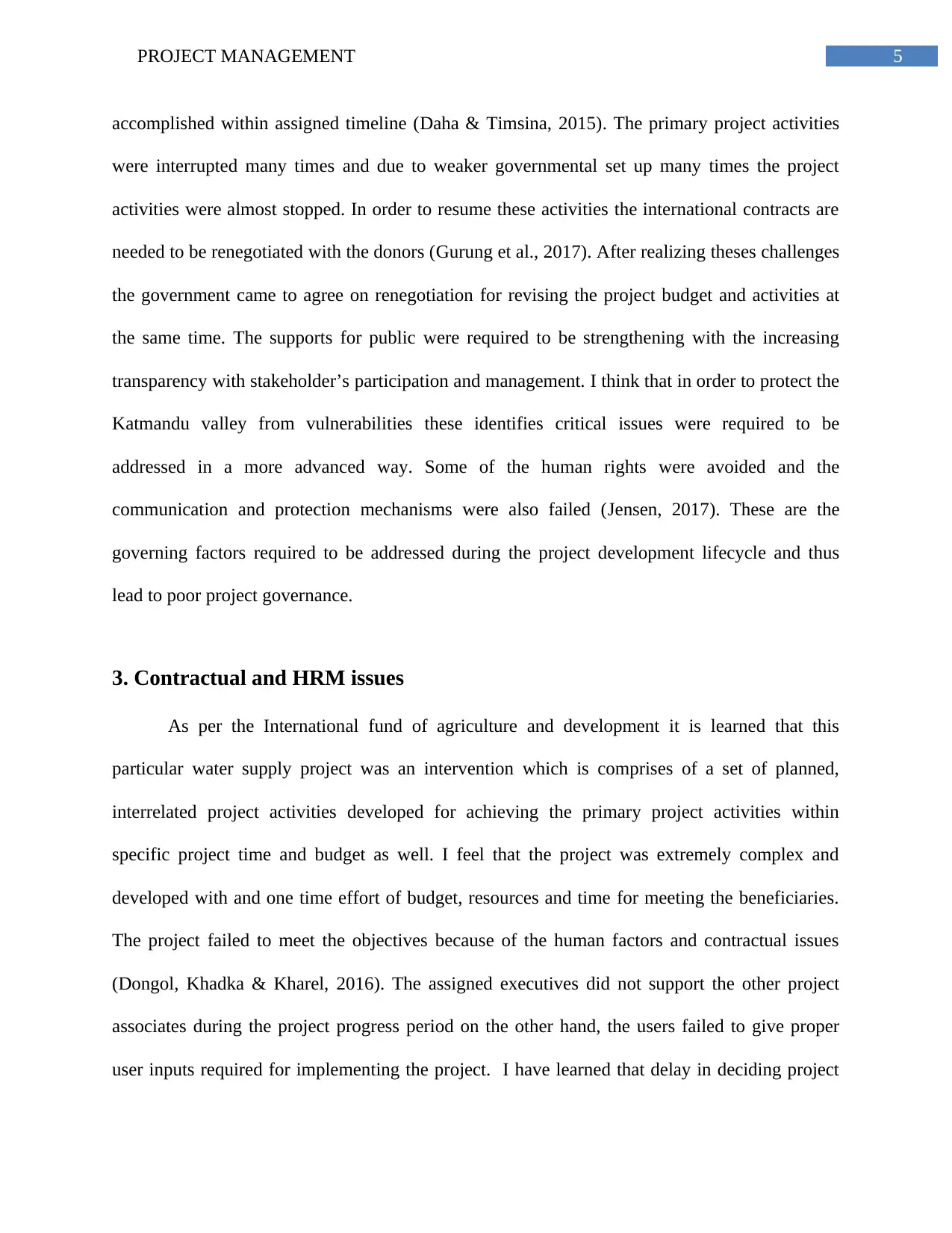
5PROJECT MANAGEMENT
accomplished within assigned timeline (Daha & Timsina, 2015). The primary project activities
were interrupted many times and due to weaker governmental set up many times the project
activities were almost stopped. In order to resume these activities the international contracts are
needed to be renegotiated with the donors (Gurung et al., 2017). After realizing theses challenges
the government came to agree on renegotiation for revising the project budget and activities at
the same time. The supports for public were required to be strengthening with the increasing
transparency with stakeholder’s participation and management. I think that in order to protect the
Katmandu valley from vulnerabilities these identifies critical issues were required to be
addressed in a more advanced way. Some of the human rights were avoided and the
communication and protection mechanisms were also failed (Jensen, 2017). These are the
governing factors required to be addressed during the project development lifecycle and thus
lead to poor project governance.
3. Contractual and HRM issues
As per the International fund of agriculture and development it is learned that this
particular water supply project was an intervention which is comprises of a set of planned,
interrelated project activities developed for achieving the primary project activities within
specific project time and budget as well. I feel that the project was extremely complex and
developed with and one time effort of budget, resources and time for meeting the beneficiaries.
The project failed to meet the objectives because of the human factors and contractual issues
(Dongol, Khadka & Kharel, 2016). The assigned executives did not support the other project
associates during the project progress period on the other hand, the users failed to give proper
user inputs required for implementing the project. I have learned that delay in deciding project
accomplished within assigned timeline (Daha & Timsina, 2015). The primary project activities
were interrupted many times and due to weaker governmental set up many times the project
activities were almost stopped. In order to resume these activities the international contracts are
needed to be renegotiated with the donors (Gurung et al., 2017). After realizing theses challenges
the government came to agree on renegotiation for revising the project budget and activities at
the same time. The supports for public were required to be strengthening with the increasing
transparency with stakeholder’s participation and management. I think that in order to protect the
Katmandu valley from vulnerabilities these identifies critical issues were required to be
addressed in a more advanced way. Some of the human rights were avoided and the
communication and protection mechanisms were also failed (Jensen, 2017). These are the
governing factors required to be addressed during the project development lifecycle and thus
lead to poor project governance.
3. Contractual and HRM issues
As per the International fund of agriculture and development it is learned that this
particular water supply project was an intervention which is comprises of a set of planned,
interrelated project activities developed for achieving the primary project activities within
specific project time and budget as well. I feel that the project was extremely complex and
developed with and one time effort of budget, resources and time for meeting the beneficiaries.
The project failed to meet the objectives because of the human factors and contractual issues
(Dongol, Khadka & Kharel, 2016). The assigned executives did not support the other project
associates during the project progress period on the other hand, the users failed to give proper
user inputs required for implementing the project. I have learned that delay in deciding project
⊘ This is a preview!⊘
Do you want full access?
Subscribe today to unlock all pages.

Trusted by 1+ million students worldwide
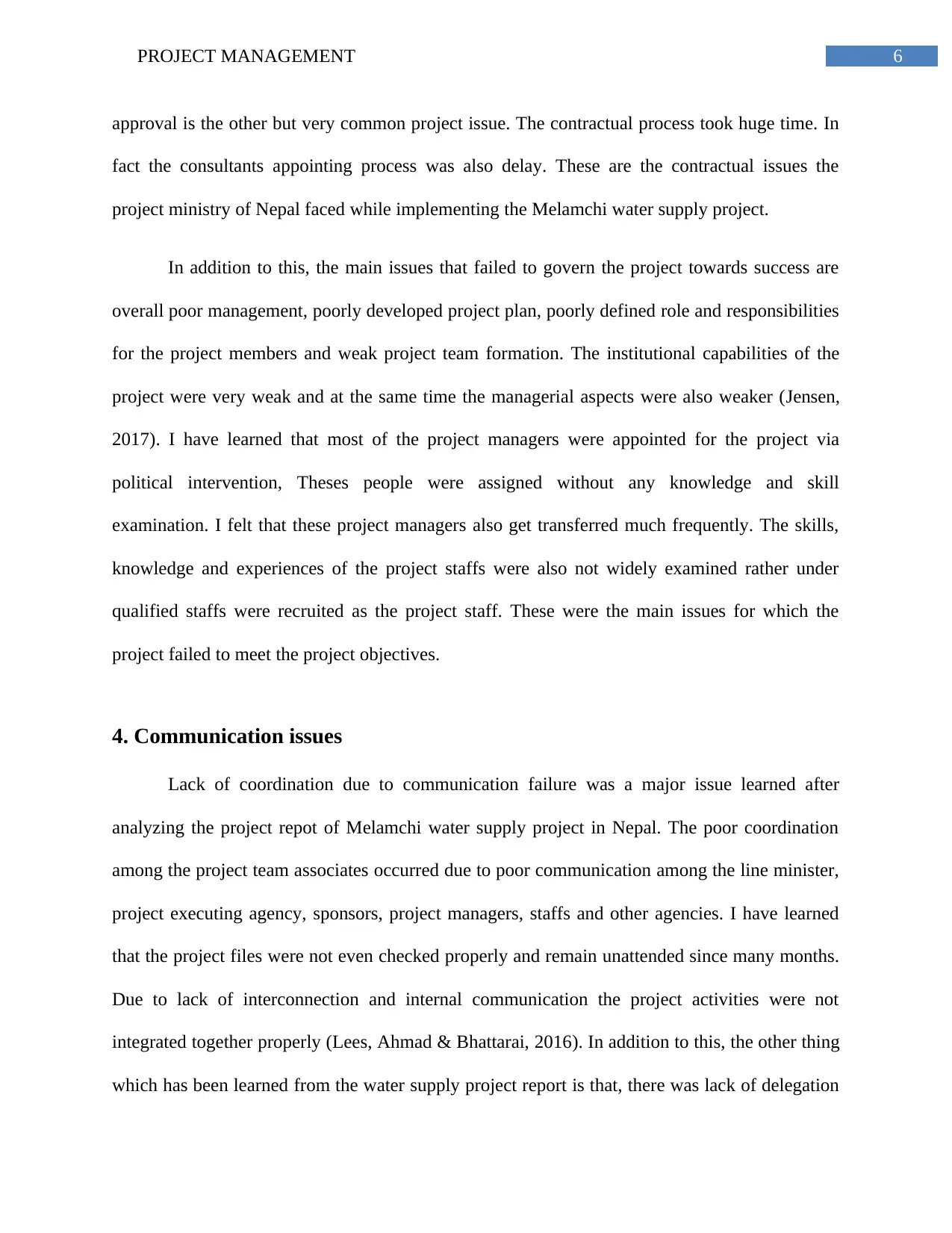
6PROJECT MANAGEMENT
approval is the other but very common project issue. The contractual process took huge time. In
fact the consultants appointing process was also delay. These are the contractual issues the
project ministry of Nepal faced while implementing the Melamchi water supply project.
In addition to this, the main issues that failed to govern the project towards success are
overall poor management, poorly developed project plan, poorly defined role and responsibilities
for the project members and weak project team formation. The institutional capabilities of the
project were very weak and at the same time the managerial aspects were also weaker (Jensen,
2017). I have learned that most of the project managers were appointed for the project via
political intervention, Theses people were assigned without any knowledge and skill
examination. I felt that these project managers also get transferred much frequently. The skills,
knowledge and experiences of the project staffs were also not widely examined rather under
qualified staffs were recruited as the project staff. These were the main issues for which the
project failed to meet the project objectives.
4. Communication issues
Lack of coordination due to communication failure was a major issue learned after
analyzing the project repot of Melamchi water supply project in Nepal. The poor coordination
among the project team associates occurred due to poor communication among the line minister,
project executing agency, sponsors, project managers, staffs and other agencies. I have learned
that the project files were not even checked properly and remain unattended since many months.
Due to lack of interconnection and internal communication the project activities were not
integrated together properly (Lees, Ahmad & Bhattarai, 2016). In addition to this, the other thing
which has been learned from the water supply project report is that, there was lack of delegation
approval is the other but very common project issue. The contractual process took huge time. In
fact the consultants appointing process was also delay. These are the contractual issues the
project ministry of Nepal faced while implementing the Melamchi water supply project.
In addition to this, the main issues that failed to govern the project towards success are
overall poor management, poorly developed project plan, poorly defined role and responsibilities
for the project members and weak project team formation. The institutional capabilities of the
project were very weak and at the same time the managerial aspects were also weaker (Jensen,
2017). I have learned that most of the project managers were appointed for the project via
political intervention, Theses people were assigned without any knowledge and skill
examination. I felt that these project managers also get transferred much frequently. The skills,
knowledge and experiences of the project staffs were also not widely examined rather under
qualified staffs were recruited as the project staff. These were the main issues for which the
project failed to meet the project objectives.
4. Communication issues
Lack of coordination due to communication failure was a major issue learned after
analyzing the project repot of Melamchi water supply project in Nepal. The poor coordination
among the project team associates occurred due to poor communication among the line minister,
project executing agency, sponsors, project managers, staffs and other agencies. I have learned
that the project files were not even checked properly and remain unattended since many months.
Due to lack of interconnection and internal communication the project activities were not
integrated together properly (Lees, Ahmad & Bhattarai, 2016). In addition to this, the other thing
which has been learned from the water supply project report is that, there was lack of delegation
Paraphrase This Document
Need a fresh take? Get an instant paraphrase of this document with our AI Paraphraser
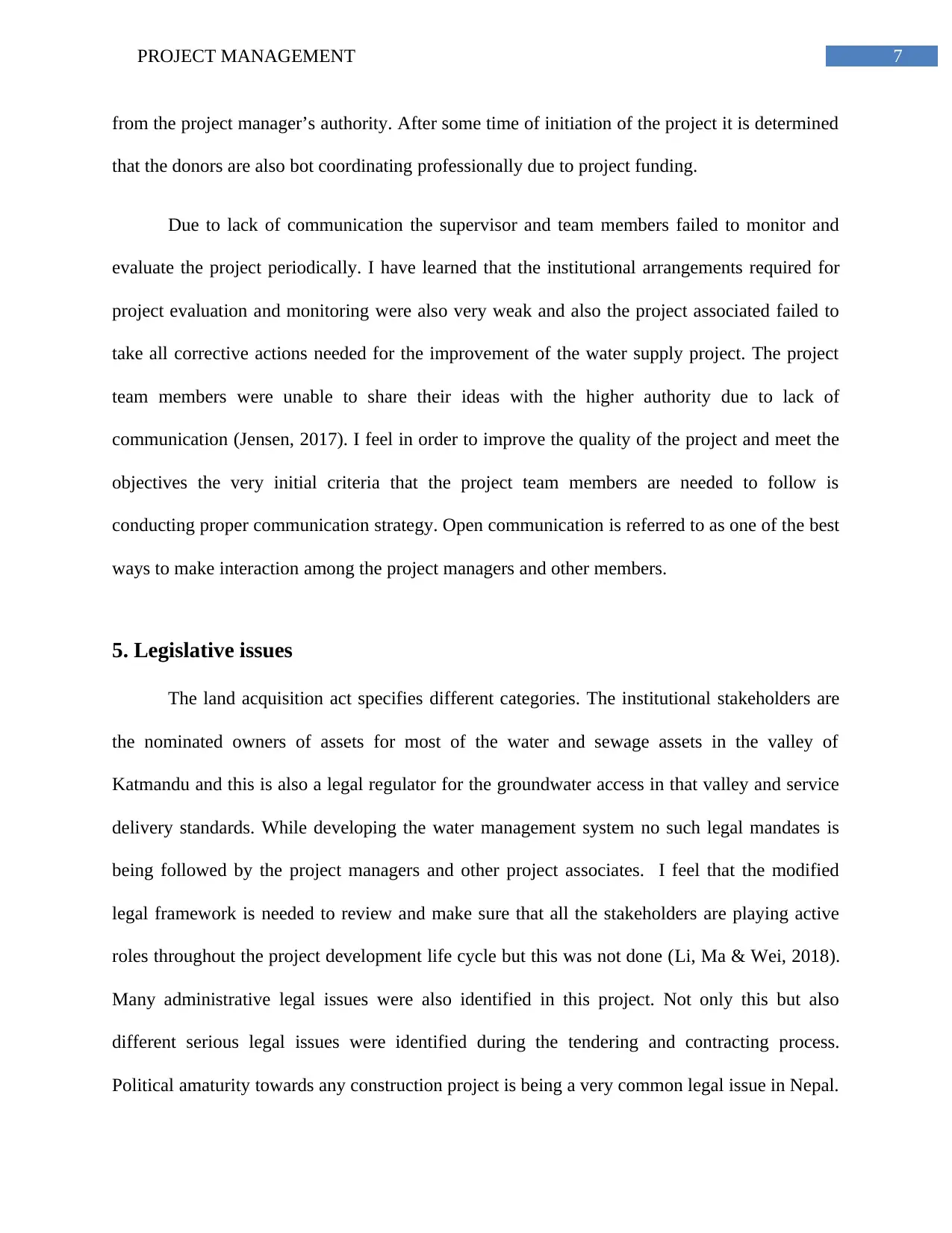
7PROJECT MANAGEMENT
from the project manager’s authority. After some time of initiation of the project it is determined
that the donors are also bot coordinating professionally due to project funding.
Due to lack of communication the supervisor and team members failed to monitor and
evaluate the project periodically. I have learned that the institutional arrangements required for
project evaluation and monitoring were also very weak and also the project associated failed to
take all corrective actions needed for the improvement of the water supply project. The project
team members were unable to share their ideas with the higher authority due to lack of
communication (Jensen, 2017). I feel in order to improve the quality of the project and meet the
objectives the very initial criteria that the project team members are needed to follow is
conducting proper communication strategy. Open communication is referred to as one of the best
ways to make interaction among the project managers and other members.
5. Legislative issues
The land acquisition act specifies different categories. The institutional stakeholders are
the nominated owners of assets for most of the water and sewage assets in the valley of
Katmandu and this is also a legal regulator for the groundwater access in that valley and service
delivery standards. While developing the water management system no such legal mandates is
being followed by the project managers and other project associates. I feel that the modified
legal framework is needed to review and make sure that all the stakeholders are playing active
roles throughout the project development life cycle but this was not done (Li, Ma & Wei, 2018).
Many administrative legal issues were also identified in this project. Not only this but also
different serious legal issues were identified during the tendering and contracting process.
Political amaturity towards any construction project is being a very common legal issue in Nepal.
from the project manager’s authority. After some time of initiation of the project it is determined
that the donors are also bot coordinating professionally due to project funding.
Due to lack of communication the supervisor and team members failed to monitor and
evaluate the project periodically. I have learned that the institutional arrangements required for
project evaluation and monitoring were also very weak and also the project associated failed to
take all corrective actions needed for the improvement of the water supply project. The project
team members were unable to share their ideas with the higher authority due to lack of
communication (Jensen, 2017). I feel in order to improve the quality of the project and meet the
objectives the very initial criteria that the project team members are needed to follow is
conducting proper communication strategy. Open communication is referred to as one of the best
ways to make interaction among the project managers and other members.
5. Legislative issues
The land acquisition act specifies different categories. The institutional stakeholders are
the nominated owners of assets for most of the water and sewage assets in the valley of
Katmandu and this is also a legal regulator for the groundwater access in that valley and service
delivery standards. While developing the water management system no such legal mandates is
being followed by the project managers and other project associates. I feel that the modified
legal framework is needed to review and make sure that all the stakeholders are playing active
roles throughout the project development life cycle but this was not done (Li, Ma & Wei, 2018).
Many administrative legal issues were also identified in this project. Not only this but also
different serious legal issues were identified during the tendering and contracting process.
Political amaturity towards any construction project is being a very common legal issue in Nepal.
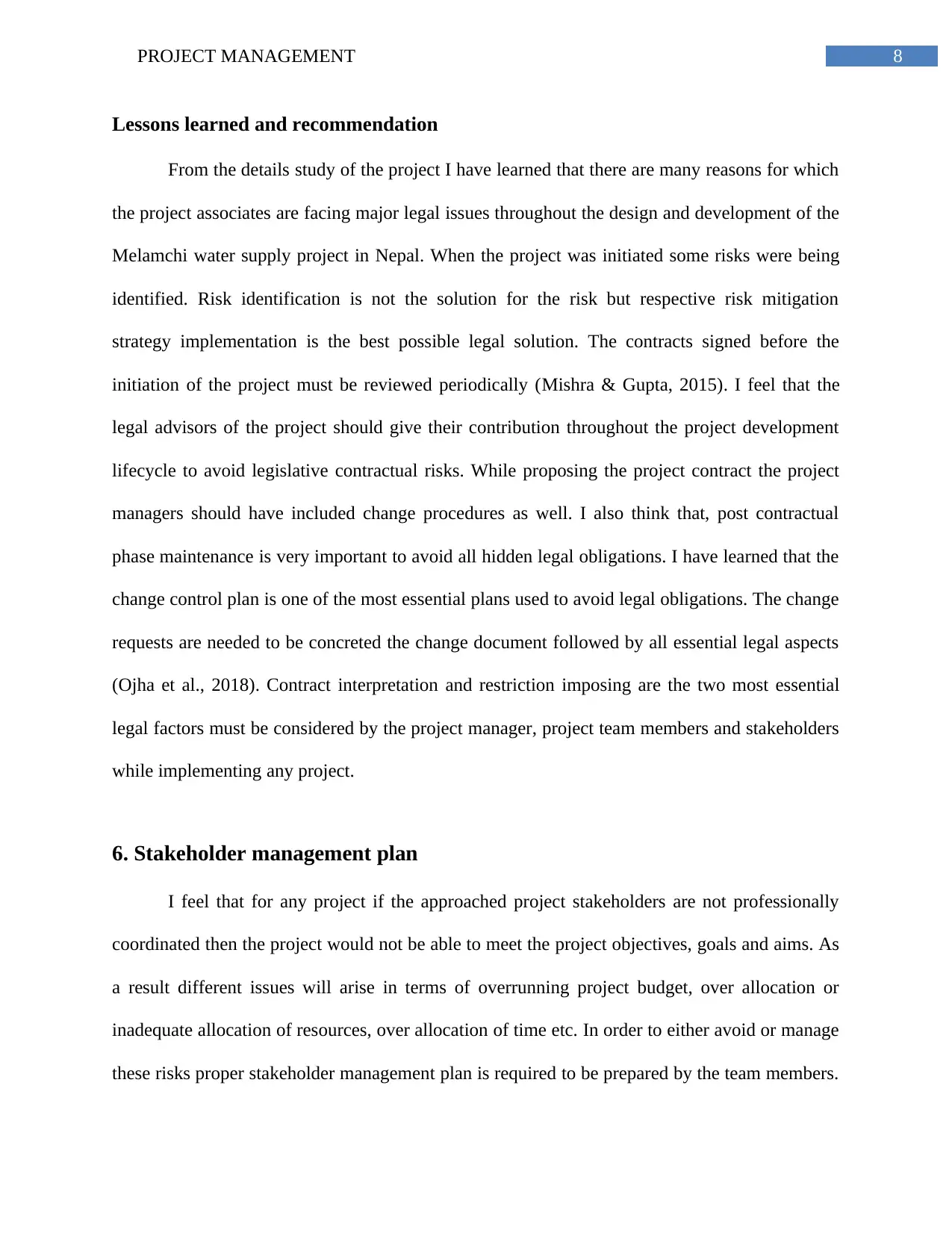
8PROJECT MANAGEMENT
Lessons learned and recommendation
From the details study of the project I have learned that there are many reasons for which
the project associates are facing major legal issues throughout the design and development of the
Melamchi water supply project in Nepal. When the project was initiated some risks were being
identified. Risk identification is not the solution for the risk but respective risk mitigation
strategy implementation is the best possible legal solution. The contracts signed before the
initiation of the project must be reviewed periodically (Mishra & Gupta, 2015). I feel that the
legal advisors of the project should give their contribution throughout the project development
lifecycle to avoid legislative contractual risks. While proposing the project contract the project
managers should have included change procedures as well. I also think that, post contractual
phase maintenance is very important to avoid all hidden legal obligations. I have learned that the
change control plan is one of the most essential plans used to avoid legal obligations. The change
requests are needed to be concreted the change document followed by all essential legal aspects
(Ojha et al., 2018). Contract interpretation and restriction imposing are the two most essential
legal factors must be considered by the project manager, project team members and stakeholders
while implementing any project.
6. Stakeholder management plan
I feel that for any project if the approached project stakeholders are not professionally
coordinated then the project would not be able to meet the project objectives, goals and aims. As
a result different issues will arise in terms of overrunning project budget, over allocation or
inadequate allocation of resources, over allocation of time etc. In order to either avoid or manage
these risks proper stakeholder management plan is required to be prepared by the team members.
Lessons learned and recommendation
From the details study of the project I have learned that there are many reasons for which
the project associates are facing major legal issues throughout the design and development of the
Melamchi water supply project in Nepal. When the project was initiated some risks were being
identified. Risk identification is not the solution for the risk but respective risk mitigation
strategy implementation is the best possible legal solution. The contracts signed before the
initiation of the project must be reviewed periodically (Mishra & Gupta, 2015). I feel that the
legal advisors of the project should give their contribution throughout the project development
lifecycle to avoid legislative contractual risks. While proposing the project contract the project
managers should have included change procedures as well. I also think that, post contractual
phase maintenance is very important to avoid all hidden legal obligations. I have learned that the
change control plan is one of the most essential plans used to avoid legal obligations. The change
requests are needed to be concreted the change document followed by all essential legal aspects
(Ojha et al., 2018). Contract interpretation and restriction imposing are the two most essential
legal factors must be considered by the project manager, project team members and stakeholders
while implementing any project.
6. Stakeholder management plan
I feel that for any project if the approached project stakeholders are not professionally
coordinated then the project would not be able to meet the project objectives, goals and aims. As
a result different issues will arise in terms of overrunning project budget, over allocation or
inadequate allocation of resources, over allocation of time etc. In order to either avoid or manage
these risks proper stakeholder management plan is required to be prepared by the team members.
⊘ This is a preview!⊘
Do you want full access?
Subscribe today to unlock all pages.

Trusted by 1+ million students worldwide
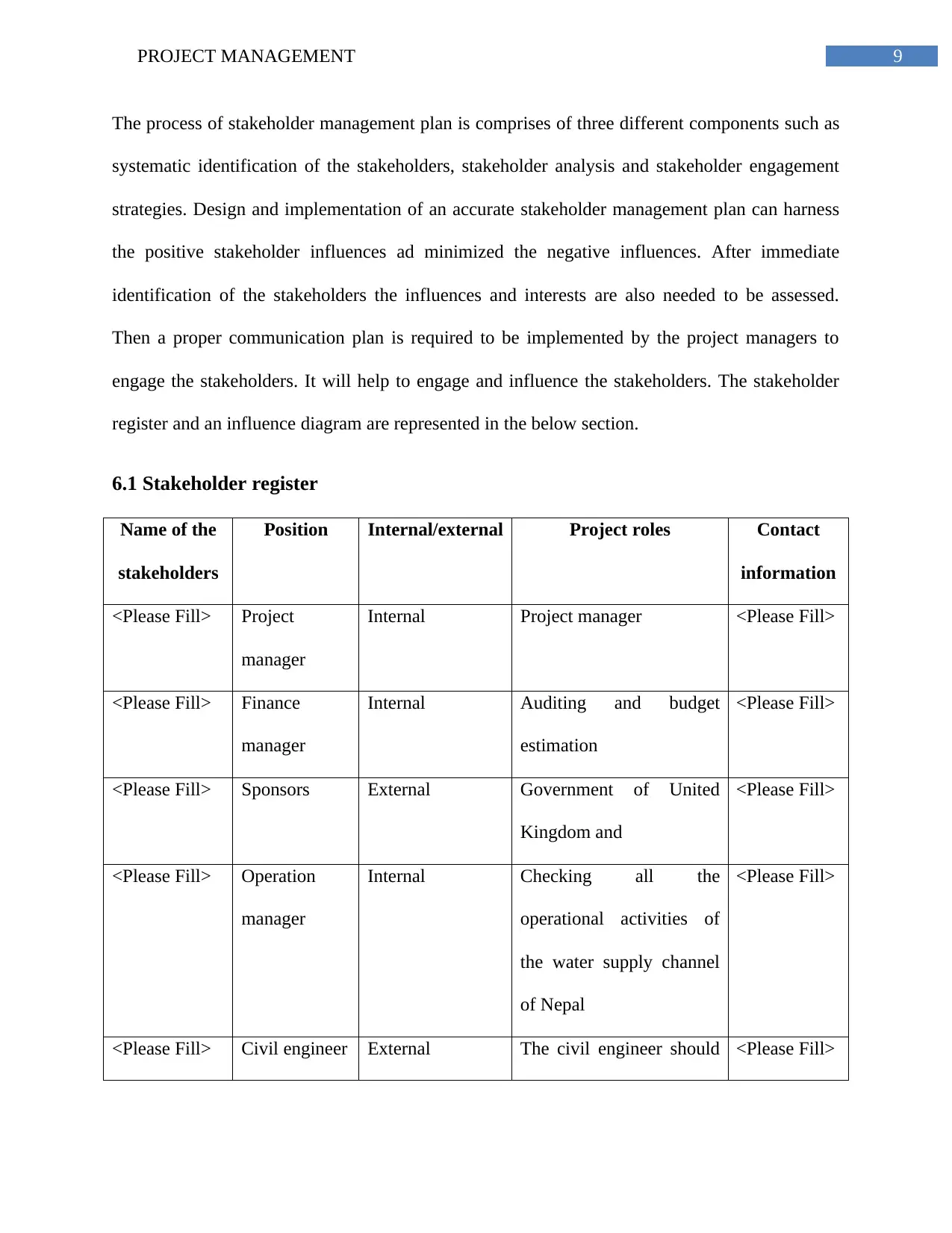
9PROJECT MANAGEMENT
The process of stakeholder management plan is comprises of three different components such as
systematic identification of the stakeholders, stakeholder analysis and stakeholder engagement
strategies. Design and implementation of an accurate stakeholder management plan can harness
the positive stakeholder influences ad minimized the negative influences. After immediate
identification of the stakeholders the influences and interests are also needed to be assessed.
Then a proper communication plan is required to be implemented by the project managers to
engage the stakeholders. It will help to engage and influence the stakeholders. The stakeholder
register and an influence diagram are represented in the below section.
6.1 Stakeholder register
Name of the
stakeholders
Position Internal/external Project roles Contact
information
<Please Fill> Project
manager
Internal Project manager <Please Fill>
<Please Fill> Finance
manager
Internal Auditing and budget
estimation
<Please Fill>
<Please Fill> Sponsors External Government of United
Kingdom and
<Please Fill>
<Please Fill> Operation
manager
Internal Checking all the
operational activities of
the water supply channel
of Nepal
<Please Fill>
<Please Fill> Civil engineer External The civil engineer should <Please Fill>
The process of stakeholder management plan is comprises of three different components such as
systematic identification of the stakeholders, stakeholder analysis and stakeholder engagement
strategies. Design and implementation of an accurate stakeholder management plan can harness
the positive stakeholder influences ad minimized the negative influences. After immediate
identification of the stakeholders the influences and interests are also needed to be assessed.
Then a proper communication plan is required to be implemented by the project managers to
engage the stakeholders. It will help to engage and influence the stakeholders. The stakeholder
register and an influence diagram are represented in the below section.
6.1 Stakeholder register
Name of the
stakeholders
Position Internal/external Project roles Contact
information
<Please Fill> Project
manager
Internal Project manager <Please Fill>
<Please Fill> Finance
manager
Internal Auditing and budget
estimation
<Please Fill>
<Please Fill> Sponsors External Government of United
Kingdom and
<Please Fill>
<Please Fill> Operation
manager
Internal Checking all the
operational activities of
the water supply channel
of Nepal
<Please Fill>
<Please Fill> Civil engineer External The civil engineer should <Please Fill>
Paraphrase This Document
Need a fresh take? Get an instant paraphrase of this document with our AI Paraphraser
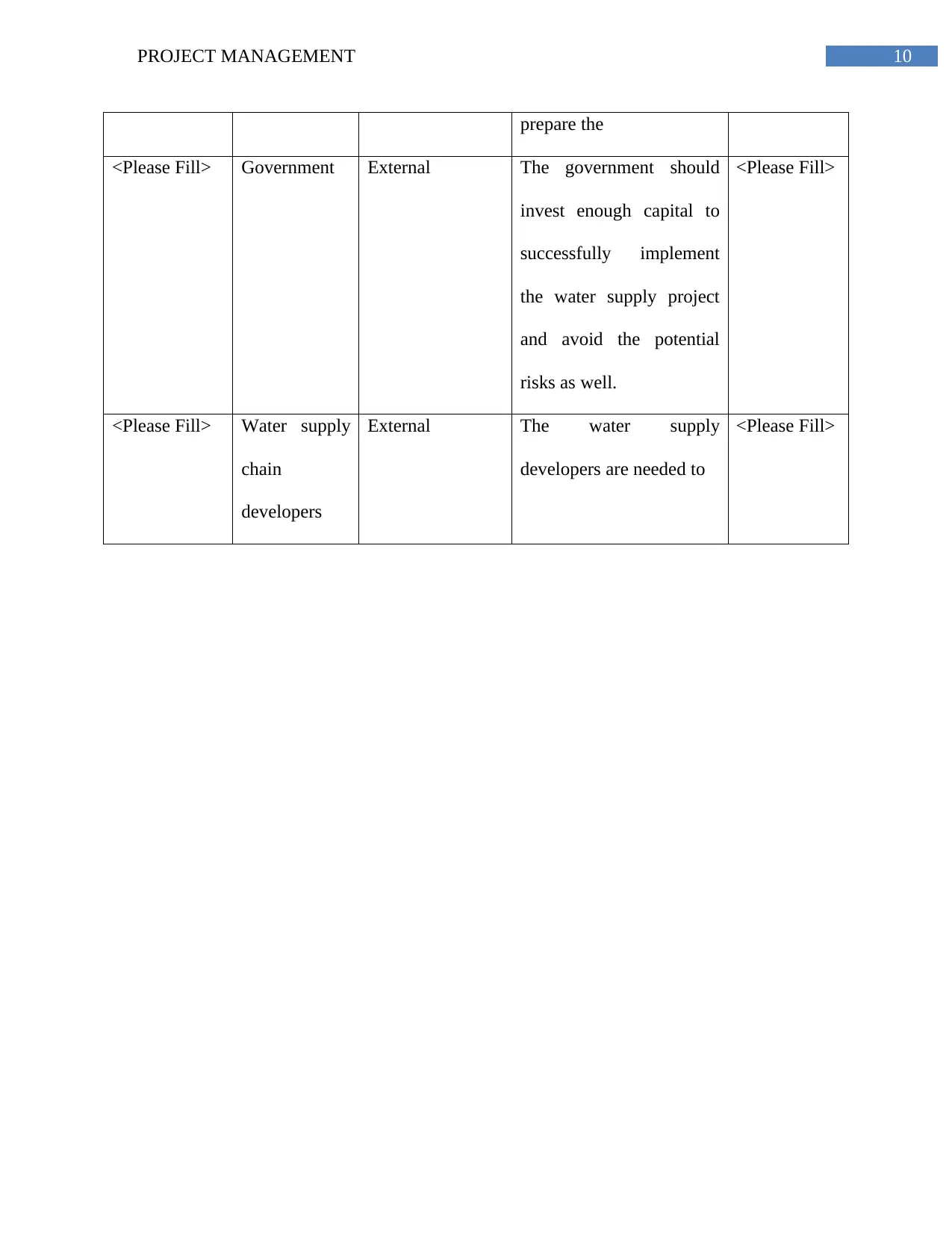
10PROJECT MANAGEMENT
prepare the
<Please Fill> Government External The government should
invest enough capital to
successfully implement
the water supply project
and avoid the potential
risks as well.
<Please Fill>
<Please Fill> Water supply
chain
developers
External The water supply
developers are needed to
<Please Fill>
prepare the
<Please Fill> Government External The government should
invest enough capital to
successfully implement
the water supply project
and avoid the potential
risks as well.
<Please Fill>
<Please Fill> Water supply
chain
developers
External The water supply
developers are needed to
<Please Fill>
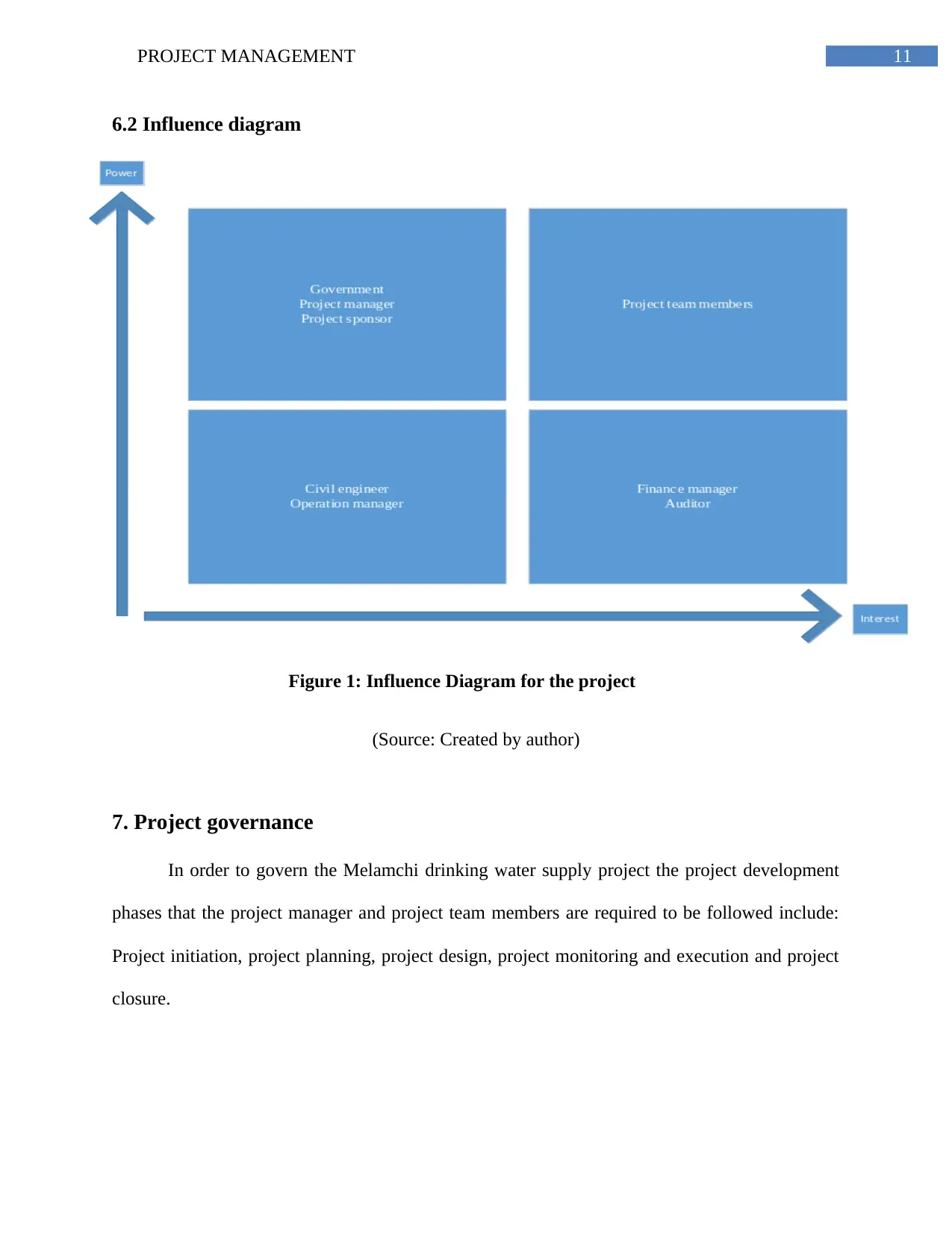
11PROJECT MANAGEMENT
6.2 Influence diagram
Figure 1: Influence Diagram for the project
(Source: Created by author)
7. Project governance
In order to govern the Melamchi drinking water supply project the project development
phases that the project manager and project team members are required to be followed include:
Project initiation, project planning, project design, project monitoring and execution and project
closure.
6.2 Influence diagram
Figure 1: Influence Diagram for the project
(Source: Created by author)
7. Project governance
In order to govern the Melamchi drinking water supply project the project development
phases that the project manager and project team members are required to be followed include:
Project initiation, project planning, project design, project monitoring and execution and project
closure.
⊘ This is a preview!⊘
Do you want full access?
Subscribe today to unlock all pages.

Trusted by 1+ million students worldwide
1 out of 24
Related Documents
Your All-in-One AI-Powered Toolkit for Academic Success.
+13062052269
info@desklib.com
Available 24*7 on WhatsApp / Email
![[object Object]](/_next/static/media/star-bottom.7253800d.svg)
Unlock your academic potential
Copyright © 2020–2025 A2Z Services. All Rights Reserved. Developed and managed by ZUCOL.





